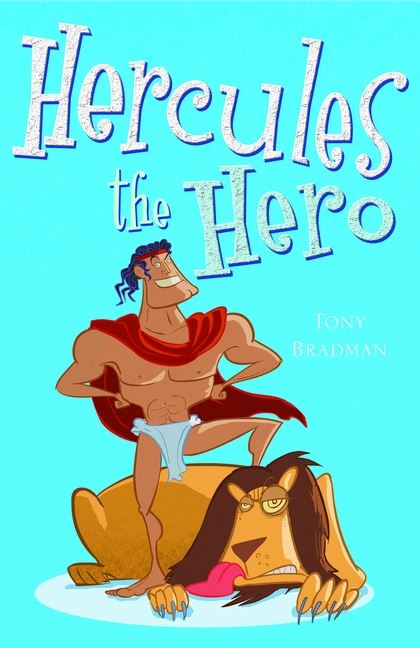Title of the work
Country of the First Edition
Country/countries of popularity
Original Language
First Edition Date
First Edition Details
Tony Bradman, Hercules the Hero. London: Bloomsbury Publishing, 2008, 48 pp.
ISBN
Official Website
bloomsbury.com (accessed: October 10, 2018)
Genre
Action and adventure fiction
Adaptations
Instructional and educational works
Myths
Target Audience
Children (age 7–8)
Cover

Courtesy of Bloomsbury Publishing.
Author of the Entry:
Tikva Schein, Bar-Ilan University, tikva.blaukopf@gmail.com
Peer-reviewer of the Entry:
Lisa Maurice, Bar-Ilan University, lisa.maurice@biu.ac.il
Susan Deacy, University of Roehampton, s.deacy@roehampton.ac.uk

Courtesy of the Author
Tony Bradman
, b. 1954
(Author)
Tony Bradman is a British born author of children’s books and short fiction pieces. He was born in London and still lives there. He cites The Hobbit and the novels of Rosemary Sutcliffe as early influences on his love of reading (see here, accessed: July 4, 2018). After studying at Cambridge University he became a journalist, eventually writing reviews of children's literature for a magazine called Parents. He has been a children's author since the 1980s, and is arguably best known for his long-lasting series about Dilly the Dinosaur (1986–1994), which sold over two million copies globally. He earned renown for this series. His historical titles include Spartacus (with Tom Bradman), The Story of Boudicca, and Harald Hardnut and he has published a considerable number of retellings of traditional myths and legends.
He has published over seventy stand-alone books and four popular series. His work has been published by Methuen Publishing, Aldred A. Knopf, Puffin Books and Harper Collins.
Before dedicating his time fully to writing children’s literature in 1984, Bradman worked as a music writer and reviewer of children’s books.
Sources:
Official website (accessed: October 10, 2018)
Profile at the wikipedia.org (accessed: October 10, 2018)
Profile at the walker.co.uk (accessed: October 10, 2018)
Profile at the penguin.co.uk (accessed: October 10, 2018)
Bio prepared by Sonya Nevin, University of Roehampton, sonya.nevin@roehampton.ac.uk and Tikva Schein, Bar-Ilan University, tikva.blaukopf@gmail.com
Questionnaire
1. What drew you to writing / working with Classical Antiquity and what challenges did you face in selecting, representing, or adapting particular myths or stories?
I’ve always enjoyed the myths and legends of the Greeks, and have re-told quite a few. They’re great stories, and the main challenges are in getting the level right for younger children – and also dealing with some of the more extreme violence! There’s lots of gory stuff in the myths, and you need some jeopardy to generate suspense, but you have to be careful most to go too far.
2. Why do you think classical / ancient myths, history, and literature continue to resonate with young audiences?
The great myths and legends have lasted because they’re great stories, and they tell us a lot about what it means to be human. They’re stories about young characters facing overwhelming odds (Theseus and Jason), tales of betrayal and revenge (Electra and Medea). Even Hercules is more than just a hero… The stories are also embedded in European culture and the cultures of countries settled or influenced by Europeans…
3. Do you have a background in classical education (Latin or Greek at school or classes at the University)? What sources are you using? Scholarly work? Wikipedia? Are there any books that made an impact on you in this respect?
I did study Latin and Greek at school, and have tried to improve my skills in both languages. I read some of the original texts, but also good translations. For background I surfed the web – lots of websites (some good, lots not very good at all) – Wikipedia is always useful!
4. Did you think about how Classical Antiquity would translate for young readers, esp. in (insert relevant country)? How concerned were you with “accuracy” or “fidelity” to the original? (another way of saying that might be – that I think writers are often more “faithful” to originals in adapting its spirit rather than being tied down at the level of detail – is this something you thought about?)
For children it’s really a case of being “faithful” to the original – the originals are quite hard and violent, and can also be confusing. I’m very keen to re-tell the myths in a contemporary way, with lots of action and suspense and good characters and dialogue. And because the tales are so rich, that’s easier than it sounds.
5. Are you planning any further forays into classical material?
I’m writing a lot of historical fiction these days – I’m currently working on a story about the revolt of Boudica against the Romans in Britain – and I’ve always wanted to write the story with Telemachus as the central character.
Prepared by Tikva Schein, Bar-Ilan University, tikva.blaukopf@gmail.com

Steve May (Illustrator)
Steve May is a London based illustrator with professional background in animation. He has been the graphics pen behind many well-known illustrations, including The Diary of Dennis the Menace.
Born in Hastings, he received qualification in painting and filmmaking from Trent Polytechnic and his MA in Animation from the Royal College of Art.
He worked as animation director of the films Anger, Rabbits, Gut, and Round. The first two won the Association of Illustrators Gold New Media Award in 2012 and 2010. Some of May’s work, including Cyberstreetwise, Spacehopper Man, have appeared in advertisements and on TV. His clients include, non-exlusively, Marks & Spencer, Harper Collins, The Guardian, The Economist, Puffin & Faber.
At present May is providing material via his agents Picasso Pictures and Arena.
Sources:
Official website (accessed: October 10, 2018)
Profile at the arenaillustration.com (accessed: October 10, 2018)
Profile at the littletiger.co.uk (accessed: October 10, 2018)
Profile at the picassopictures.com (accessed: October 10, 2018)
Bio prepared by Tikva Schein, Bar-Ilan University, tikva.blaukopf@gmail.com
Summary
In five illustrated chapters, Bradman tells the story of Hercules the Hero. In Chapter One, Trouble with a goddess, we learn of Hercules’ unusual powers and Hera’s enmity towards him. In Chapter Two, Some interesting little jobs, Hercules tackles the Nemean Lion and the Hydra. In Chapter Three, A few busy weeks, Hercules captures the Deer with the Golden Horns and the Brutal Board and cleanses the Augean stables. He shoots down the Bronze Birds of Stymphalos, wrestles with the Great Bull of Crete and rounds up the Man-eating Horses of King Diomedes. Chapter Four, A battle…and some apples, has Hercules grabbing a belt from the queen of the Amazons, stealing the White Cattle from the ogre Geryon and fetching the Golden Apples of Paradise.
At Hera’s increasing fuming over Hercules’ unexpected success, Chapter Five, To hell and back, has Hercules challenged to bring King Eurystheus the Hound of Hades. Hercules’ labours end whimsically with a tickled Hera laughing at the image of King Eurystheus running around his palace chased by Cerberus and conceding to Hercules, “becoming the best of friends”.
Analysis
Bradman’s retelling of the Hercules myth is breezy and lighthearted. This accessibility of mythological life brings the reader into the world of Hercules. Admittedly, the tense clip through the book means that though the action is vivid, it is not rich. However, given the target audience of this book is ages 7–8, the sparsity of description and plot depth is sufficient. The text is in large-sized font which invites the reader to use this as a chapter book for practising reading skills. The line-drawing illustrations are comical and cartoon style. They show no reverence or dignity for the characters, which makes the reading an amusing one. The content does not presuppose any prior knowledge of the classical world for reading and the proper nouns used in the narrative are few so that the flow of the story is not interrupted by needing to look up any names. There is no glossary for reference as this is not a reference book but a story book.
The tone is jolly and jovial, e.g. “Eurystheus nearly choked on his supper when Hercules returned” (p. 22), “stop looking so smug” (p. 37), calling Cerberus, Eurystheus’ “new pet” (p. 41). There is no point at which we are concerned for Hercules or any other characters. Instead, the reader learns of the Hera-Hercules enmity as a little intra-family bickering, which Hercules takes on in a good-natured manner. E.g. “Everybody liked him [Hercules] and thought he was terrific. Everybody, that is, except one of the Immortal Gods” (pp. 8–9); “Hercules was still feeling confused. But then he sighed. Hera was an Immortal Goddess, so it was his duty to obey her” (p. 16). There’s no angst or heartache over Hera’s petulance.
Unlike other retellings, this story never has us on the edge of our seats, tremulously waiting to see what will happen. Instead, the story unfurls with the sense of it being a school-boy adventure.
For example, when Hercules meets Cerberus, the dog guarding Hades, he is not put into a state of dread at the “three heads all barking at once, drool dripping from its pointed fangs, its six eyes burning red” (p. 39). Without batting an eyelid, Hercules merely “gulped”, had a “brilliant idea” and asks Cerberus, “Would you like to go… walkies?” (p. 40). This somewhat tongue-in-cheek reading takes some potentially hair-raising myths and lightens the tone so that anyone can read them as an adventure story.
The Amazonian queen is presented as “the toughest” of the “incredibly fierce women warriors” (p. 30). The gender presentation, together with the illustrations, shows the Amazonian women as strong and feisty women. “There was a terrific battle that lasted for hours, and Hercules just managed to hold them off. Finally, he grabbed the belt…and ran” (p. 31). The depiction here of Hercules only just able to fulfil this task, with his utmost being, stands in contrast to the other tasks where Hercules is presented as on top of his game. There is an educative aspect for the young readers of how to ask for something which is not yours – Hercules first “asked her [the Amazonian queen] nicely if he could have her belt” (p. 30) and after stealing it, he says “Sorry!” (p. 31).
Hera herself is given more space than we might have expected in a retelling of Hercules’ labours, such that the two main protagonists end up being herself and Hercules, with Hera pitting her frustrations against Heracles. The pleasant coda of Hercules’ begging Hera’s forgiveness – “Forgive me, mighty Hera, I beg you,” (p. 43) – for letting the dog Cerberus loose around Eurystheus’ palace for larks, (“He let Cerberus off the leash, and the dog barked with joy…and chases the screaming king round and round the hall” (p. 42)), is met with an amiable response. Hera is shown to have more than the one side of jealousy and snobbery that we saw on p. 9 – “She didn’t like to see a mere human having all that fame and success”. Hera is presented as having a sense of humour that was tickled by Hercules’ boyish antics, leading her to forgiveness herself – “That’s the funniest thing I’ve seen in ages. Maybe you’re not such a bad lad after all!” (p. 43).
Indeed, the last words of the story are given to questioning the moral calibre of the gods and not to focussing on Hercules. “…the Immortal Gods couldn’t possibly be that cruel, could they?” (p. 44). This ending shows the spotlight of the book as having been on machinations of the Immortal Gods and not necessarily just on Hercules.
Further Reading
Hoena, Blake, The 12 Labors of Hercules: A Graphic Retelling. Ancient Myths, North Mankato: Capstone Press, 2015.
Powell, Martin, The Adventures of Hercules: A Graphic Novel. Graphic Resolve, North Mankato: Stone Arch Books, 2014.
Van Lente, Fred, Hercules. Heroes and Legends, New York: Rosen Publishing, 2015.


